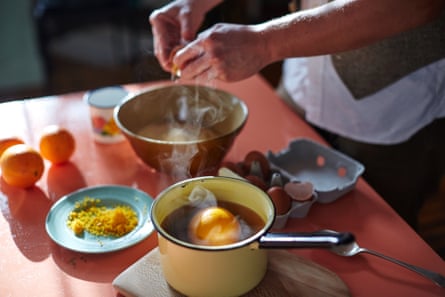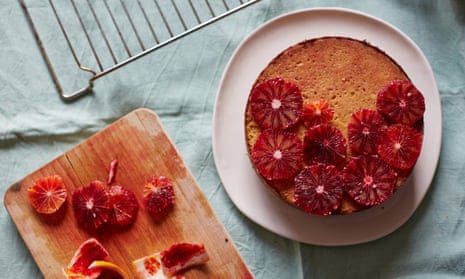When I was 10, my family relocated from London to a small village in Dorset. I was a city boy and the move meant starting my young life afresh. With our new house we inherited two goats, Boot and Cassy, who I was given the task of milking before school every morning, come rain or shine. It wasn’t always pleasant, but the goat’s milk on porridge for breakfast was worth it.
My mum also gave me a patch of land in the garden, which I filled with nothing but peas. I still remember the annual harvest, picking pods and splitting them open, little green spheres popping everywhere. To this day they are the best peas I’ve ever eaten – so sweet, so utterly fresh.
I’m sure that being involved with growing and preparing our family meals from such a young age is the reason I cook today. Rearing animals helped me to understand the inherent value of food, and harvesting my own vegetables drummed in the basic – yet so often forgotten – principle that food should be seasonal and come from the ground.
Nowadays, I share the ideals of Slow Food, an international organisation and movement that campaigns for a sustainable food system. Its main aim is to fight for food security and “sovereignty”: in other words, the right to grow, cultivate and store food from within a culture, so that countries can feed themselves self-sufficiently. Its message is simple yet profound: food should be good, clean, fair and for everyone.

At its last biannual conference in Italy, where thousands of artisanal and indigenous producers congregated from every corner of the world, the words of a South American delegate resonated and stuck with me: “food is our connection with nature”. Separated as city dwellers are from nature, I feel this is more important than ever now that I live back in London again.
These days my recipes revolve around seasonal vegetables – my cooking moves in tandem with the British weather. Abstaining from the use of non-seasonal vegetables means that I can focus on the best products at a given time of year – root veg such as beetroot in winter, the summer’s bright tomatoes, or autumnal apples. Even when we are in the midst of the so-called “hungry gap” – that cold period in between winter and spring, when locally grown vegetables are scarce – we have an inspiring selection of vegetables being harvested on UK soil, and the likes of oranges from the Mediterranean.
My favourite winter ingredient – forced rhubarb – has just brightened my nearby greengrocer’s shelves. These blushing pink strands are grown in dark sheds in Yorkshire and are rather romantically – how apt for Valentine’s Day! – picked by candlelight so as not to disturb their growth, colour and flavour.
I use rhubarb in dishes both savoury and sweet – you’ll find it fermented and jarred with spices in next week’s column, and accompanying the sugar-free cake below in a parfait sweetened with maple syrup.
Unrefined ingredients such as honey, and maple and date syrups, are a fantastic natural source of sweetness, as are dried fruits such as dates and unsulphured apricots. The two recipes here use dried fruit and maple syrup for sweetness to enhance the season’s fresh bounty of gorgeous blood oranges and forced rhubarb.
Getting under the skin of seasonal cooking takes a little homework. I hope, however, that on making these two recipes, its inherent simplicity – and supremacy of flavours – will be revealed to you.
Orange and olive oil cake (that happens to be sugar free)
Blood oranges are in season for just a few months. Make the most of them while you can. This cake has a tang like marmalade and a toffeed sweetness from the apricots.

1 large orange, washed
250g dried unsulphured apricots
2 tbsp olive oil
6 eggs
250g ground almonds
2 tsp baking powder
2 blood or sweet oranges, peeled and sliced
A little maple syrup
1 Grate the zest off of the orange and put aside. Then boil the orange in a small saucepan for 1½ hours – or until the rind is soft. Add 150g of the apricots and boil for a further 5 minutes. Drain and blend into a puree.
2 Preheat the oven to 170C/335F/gas mark 3½. Grease and flour a 20cm cake tin.
3 In a mixing bowl combine the rest of the apricot chopped into small pieces with the orange zest, olive oil, eggs, ground almonds and baking powder. Stir in the orange and apricot puree until thoroughly mixed.
4 Pour into the cake tin and bake in the oven for about 50 minutes. Test the cake is cooked by inserting a butter knife. If it comes out clean, it is cooked. Allow it to cool.
5 In a dry pan, gently heat the orange slices with some maple syrup until they soften slightly. Decorate the cake with the slices.
Rhubarb and maple ice cream
This is a really simple way to make “ice-cream” at home that doesn’t need any techy equipment. The maple syrup adds a subtle depth of flavour with hints of butter, caramel and rye.
Makes 6
400g rhubarb, cut into 3cm pieces
100ml maple syrup
1 vanilla pod, deseeded
2 small eggs
150ml double cream
1 Put the rhubarb pieces into a small saucepan with half the maple syrup and the empty vanilla pod. Put a lid on top and simmer gently for 5-10 minutes until the rhubarb is soft.
2 Drain through a sieve, keeping both the pulp and the liquid. Put the liquid back on the heat and boil to reduce. When thick, syrupy and sweet, remove from the heat, combine with the rhubarb pulp and cool to fridge temperature.
3 Whisk the eggs and remaining maple syrup for 10 minutes until the eggs have quadrupled in volume.
4 Whisk the cream in a clean bowl with the vanilla seeds until it becomes thick. Fold in the rhubarb syrup, puree and egg mixture.
5 Pour the mixture into a large bowl and place (level) in the freezer for at least 4-5 hours to set.
6 Remove from the freezer 10-20 minutes before you want to serve to allow it to soften.

Comments (…)
Sign in or create your Guardian account to join the discussion